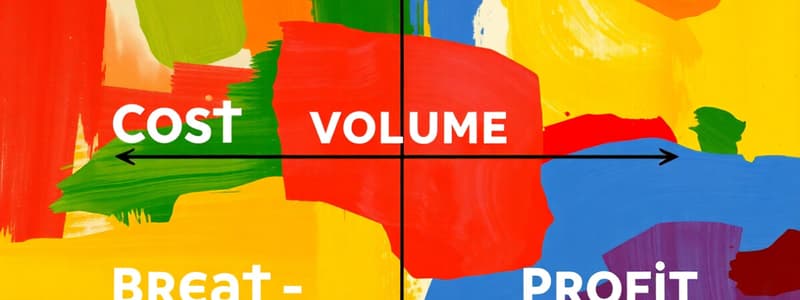Podcast
Questions and Answers
What is the break-even point (BEP)?
What is the break-even point (BEP)?
The point at which cost or expenses and revenue are equal.
Break-even analysis focuses solely on the point where revenue equals expenses, without considering profit.
Break-even analysis focuses solely on the point where revenue equals expenses, without considering profit.
False (B)
What does cost-volume-profit (CVP) analysis aim to understand?
What does cost-volume-profit (CVP) analysis aim to understand?
The interrelationships between costs, volume, and profit at various levels of activity.
What is the core question that CVP analysis asks?
What is the core question that CVP analysis asks?
What are three examples of decisions typically made using CVP analysis?
What are three examples of decisions typically made using CVP analysis?
What is the first step in preparing a CVP analysis?
What is the first step in preparing a CVP analysis?
What does the term 'contribution' represent in CVP analysis?
What does the term 'contribution' represent in CVP analysis?
What is the formula to calculate 'contribution'?
What is the formula to calculate 'contribution'?
What is the first formula needed to calculate break-even?
What is the first formula needed to calculate break-even?
What is the second formula needed to calculate break-even?
What is the second formula needed to calculate break-even?
List the three steps involved in solving a CVP problem.
List the three steps involved in solving a CVP problem.
Provide the formula for calculating the 'Contribution/Sales ratio'.
Provide the formula for calculating the 'Contribution/Sales ratio'.
What is the formula for calculating the level of sales needed to achieve a target profit (in units)?
What is the formula for calculating the level of sales needed to achieve a target profit (in units)?
What are the four key elements of the marginal costing method for calculating net income?
What are the four key elements of the marginal costing method for calculating net income?
What is the formula for calculating net profit using marginal costing?
What is the formula for calculating net profit using marginal costing?
What is the key element in the relationship between break-even and net profit within the marginal costing method?
What is the key element in the relationship between break-even and net profit within the marginal costing method?
What are the four key assumptions in CVP analysis?
What are the four key assumptions in CVP analysis?
What are the three general problems that can limit the effectiveness of break-even analysis?
What are the three general problems that can limit the effectiveness of break-even analysis?
In the context of CVP analysis, what is defined as the 'margin of safety'?
In the context of CVP analysis, what is defined as the 'margin of safety'?
Describe the two ways to calculate the margin of safety.
Describe the two ways to calculate the margin of safety.
What are the two main types of changes that can be analyzed using CVP graphs?
What are the two main types of changes that can be analyzed using CVP graphs?
What type of change does not affect the slope of the cost line in a CVP graph?
What type of change does not affect the slope of the cost line in a CVP graph?
Which of the following changes is likely to affect the shape of the profit and loss wedges in a CVP graph?
Which of the following changes is likely to affect the shape of the profit and loss wedges in a CVP graph?
Flashcards
Break-even Point (BEP)
Break-even Point (BEP)
The level of sales at which total revenue equals total costs, resulting in zero profit or loss.
Cost-Volume-Profit (CVP) Analysis
Cost-Volume-Profit (CVP) Analysis
The analysis of the relationship between costs, sales volume, and profit at different activity levels.
Fixed Costs
Fixed Costs
Costs that remain constant regardless of the volume of goods or services produced.
Variable Costs
Variable Costs
Signup and view all the flashcards
Mixed Costs
Mixed Costs
Signup and view all the flashcards
Contribution Margin
Contribution Margin
Signup and view all the flashcards
Contribution to Sales Ratio
Contribution to Sales Ratio
Signup and view all the flashcards
Break-even Point (in Units)
Break-even Point (in Units)
Signup and view all the flashcards
Break-even Point (in € Sales)
Break-even Point (in € Sales)
Signup and view all the flashcards
Margin of Safety
Margin of Safety
Signup and view all the flashcards
Marginal Costing
Marginal Costing
Signup and view all the flashcards
Break-even Graph
Break-even Graph
Signup and view all the flashcards
Contribution Break-even Graph
Contribution Break-even Graph
Signup and view all the flashcards
Profit Volume (P/V) Graph
Profit Volume (P/V) Graph
Signup and view all the flashcards
Sensitivity Analysis
Sensitivity Analysis
Signup and view all the flashcards
Margin of Safety (MoS)
Margin of Safety (MoS)
Signup and view all the flashcards
Margin of Safety (MoS) Percentage
Margin of Safety (MoS) Percentage
Signup and view all the flashcards
Constant Selling Price
Constant Selling Price
Signup and view all the flashcards
Linear Cost Behavior
Linear Cost Behavior
Signup and view all the flashcards
Constant Sales Mix
Constant Sales Mix
Signup and view all the flashcards
No Inventory Changes
No Inventory Changes
Signup and view all the flashcards
Stepped Fixed Costs
Stepped Fixed Costs
Signup and view all the flashcards
Non-Linear Relationships
Non-Linear Relationships
Signup and view all the flashcards
Multi-Product Businesses
Multi-Product Businesses
Signup and view all the flashcards
Operating Income
Operating Income
Signup and view all the flashcards
Operating Loss
Operating Loss
Signup and view all the flashcards
Target Profit Sales Volume
Target Profit Sales Volume
Signup and view all the flashcards
Contribution Per Unit
Contribution Per Unit
Signup and view all the flashcards
Cost Per Unit
Cost Per Unit
Signup and view all the flashcards
Study Notes
Cost-Volume-Profit (CVP) Relationships
- CVP analysis examines the interrelationships between costs, volume, and profit at various activity levels.
- Break-even point (BEP) is where revenue equals expenses, and net income is zero. No profit or loss is made.
- Sales above the break-even point result in a profit; below, a loss.
Break-Even Analysis
- Break-even point (BEP) is the point where total revenue equals total costs.
- There is no gain or loss, this point has been "broken even."
- A profit or loss has not yet been made.
Cost-Volume-Profit (CVP) Analysis
- It analyzes costs and profits for various activity levels beyond just the break-even point.
- It examines the effect of changes in activity on financial results.
- Understanding how costs change with volume helps managers control costs with limited resources.
- CVP analysis is ideal for short-term decisions, like pricing policies, output levels or special orders.
Preparing CVP Analysis
-
Step 1: Classify Costs
- Fixed costs remain constant regardless of output levels.
- Variable costs change proportionally with output levels.
- Mixed costs have both fixed and variable components.
-
Step 2: Calculate Contribution
- Contribution is the amount available to cover fixed costs (after all variable costs are paid).
- Contribution per unit = Selling Price – Variable Costs
- Example: Selling Price: €40, Variable Costs: €24. Contribution = €16
-
Step 3: Calculate Break-Even - a) Break-even in units: Fixed Costs / Contribution per unit. - b) Break-even in sales: Fixed Costs / Contribution per unit x Selling Price per unit.
-
Other Formulas: Contribution/Sales ratio = (Contribution per unit / Sales per unit) x 100 Level of sales to result in target profit (units) = (Fixed cost + target profit) / Contribution per unit Level of sales to result in target profit (€ sales) = (Fixed cost + Target profit) x (sales price / unit) / contribution per unit
Marginal Costing Method
- An alternative method for calculating profit.
- Formula: Sales - Variable costs – Fixed costs = Net Income
- It's useful for analyzing the break-even point by highlighting the contribution of each unit sold.
Assumptions of CVP Analysis
- Selling prices are constant within the relevant range.
- Costs are linear within the relevant range and are categorized into fixed and variable components.
- In multi-product companies, the sales mix is constant.
- In manufacturing companies, inventories do not change; the number of units produced equals the number of units sold.
Weaknesses of Break-Even Analysis
- Non-linear cost relationships frequently occur in real-world scenarios.
- Costs can be "stepped" or fixed in chunks.
- Multi-product businesses often have an uneven sales mix.
Margin of Safety
- Indicates the sales volume reduction before a company incurs a loss.
- Margin of Safety (Units) = Expected sales in units – Break-even sales in units
- Margin of Safety (Amount) = Margin of safety in Units * Sale Price Per Unit
- Margin of Safety (%) = Margin of safety in Units / Expected sales in units x 100
Sensitivity Analysis
- "What if" analysis.
- What happens if the selling price changes?
- What happens if the costs change?
- What happens if the sales mix changes?
Studying That Suits You
Use AI to generate personalized quizzes and flashcards to suit your learning preferences.




